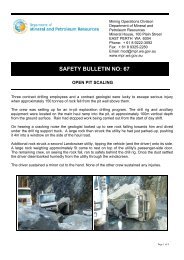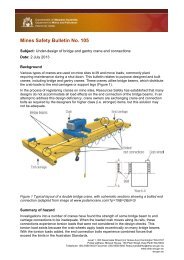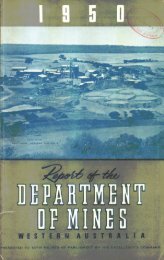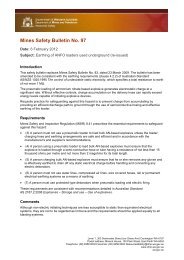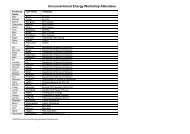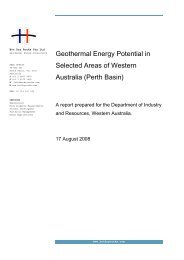Vertical opening safety practice in underground mines - guideline
Vertical opening safety practice in underground mines - guideline
Vertical opening safety practice in underground mines - guideline
You also want an ePaper? Increase the reach of your titles
YUMPU automatically turns print PDFs into web optimized ePapers that Google loves.
Where ore passes have a number of f<strong>in</strong>gers, those not<br />
<strong>in</strong> use should be scaled down, blown off and a bulkhead<br />
constructed, and this action recorded. Signs should be<br />
attached to the bulkhead <strong>in</strong>dicat<strong>in</strong>g the nature of the<br />
excavation that has thus been secured.<br />
When ore passes (or any vertical <strong>open<strong>in</strong>g</strong>) are to be closed<br />
off, whether on a temporary or a permanent basis, details<br />
of the status of the pass or <strong>open<strong>in</strong>g</strong> must be recorded on<br />
m<strong>in</strong>e plans and written records.<br />
6.3 Work<strong>in</strong>g <strong>in</strong> or near passes<br />
No-one should move onto or stand on broken rock <strong>in</strong> any<br />
ore pass, nor attempt to do any work <strong>in</strong> such a position until<br />
appropriate <strong>safety</strong> precautions have been taken.<br />
A check should be made to determ<strong>in</strong>e whether there is<br />
any possibility of a hang-up <strong>in</strong> the pass, which could result<br />
<strong>in</strong> a void <strong>in</strong> the pass below the work<strong>in</strong>g horizon that could<br />
suddenly collapse.<br />
Material fall<strong>in</strong>g through an ore pass can entra<strong>in</strong> air<br />
as it travels by any <strong>open<strong>in</strong>g</strong>s <strong>in</strong>to the pass. There are<br />
many recorded <strong>in</strong>stances of people be<strong>in</strong>g drawn <strong>in</strong>to the<br />
excavation through such <strong>open<strong>in</strong>g</strong>s. Where the potential<br />
for this hazard to arise has been identified, suitable<br />
barricades (e.g. air-grat<strong>in</strong>g, heavy gauge mesh) should<br />
be <strong>in</strong>stalled securely and appropriate warn<strong>in</strong>g signs<br />
provided.<br />
If work is required with<strong>in</strong> a pass, a safe means of entry<br />
from the top must be provided, and the whole of the<br />
pass made safe down to the work<strong>in</strong>g area. Suitable<br />
overhead protection must be provided, signs posted,<br />
and effective communication provided to a responsible<br />
person, who will rema<strong>in</strong> at the top of the pass for the<br />
duration of the work.<br />
7 Procedure for open stopes<br />
No-one should ever throw material <strong>in</strong>to open stopes,<br />
except where waste rock, scrap metal or steel pipe is<br />
be<strong>in</strong>g disposed of <strong>in</strong> a completed stope prior to fill<strong>in</strong>g.<br />
Such work must be supervised and only carried out after<br />
a clearance procedure has been followed. No organic or<br />
6 <strong>Vertical</strong> <strong>open<strong>in</strong>g</strong> <strong>safety</strong> <strong>practice</strong> <strong>in</strong> <strong>underground</strong> m<strong>in</strong>es — guidel<strong>in</strong>e




